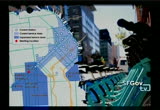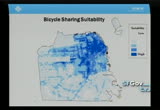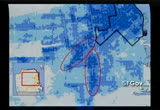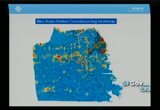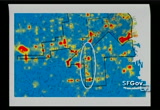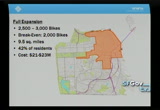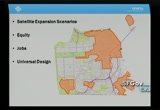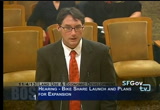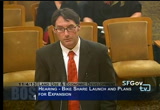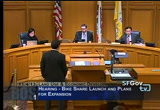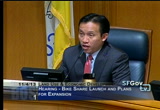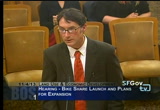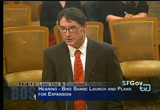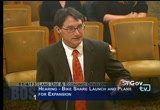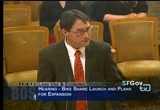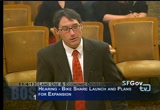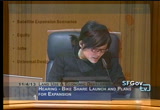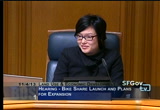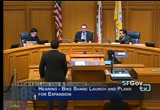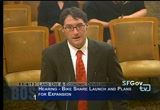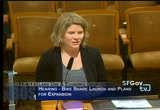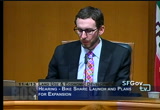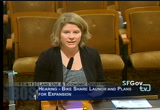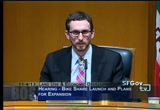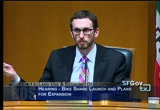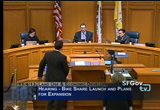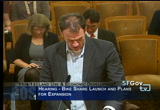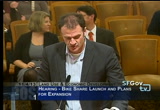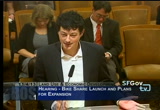tv [untitled] November 4, 2013 6:30pm-7:01pm PST
6:30 pm
if it went to where i live a little more or where i play and i think mission and upper market definitely fall into that category. i have an couple of slides that explain our thinking more on that. so this is a suitability analysis that we did. darker blue areas represent areas of extremely high bicycle sharing suitability this is based on 11 different factors according to studies in other cities correlate. so we now if we started small we wanted to be successful. >> what with are the 11 factors? >> i can't list them all but things like did he density of
6:31 pm
residents topography bicycle use walking there's a few more as well i can't think right now but i'd be happy to follow up with you on those we have a whole paper to explain the methodology. so if you zoom in on the suitability city wide obviously and if you look in the black and upper right our initial service area then you look at upper market and the mission, these are areas of extremely high suitability for bicycle sharing and when you look at soma -- we skipped a large number of the stations early on there are pockets of extremely high suitability but there's also pockets next to high suitability. in terms of
6:32 pm
prioritizing makes sense to go with the suitably areas so this is exciting too. these are maps i haven't is shown yet. much like other cities we hosted a bicycle sharing crowd sourcing map on our website allowing people from the public to go to the website and placing a dot suggesting a bicycle sharing station likewise you could like somebody's dot and so that graphic which i don't have is not that elluminating itself but using advanced mapping software we were able to produce a heat map of where the density of the requests and other people's likes were the
6:33 pm
highest and it was interesting what the results were again confirms a lot of our earlier work and this decision to move into the mission and upper market. i'll zoom in on this for you too so you can see a little better. so the area in the upper right is our initial service area and the others -- there's various expansion scenarios that we've been looking at but the area circled in white is indeed the mission valencia corridor and you see along upper market also the castro and noe valley and there's a hire density of red and yellow heat mapping than in soma so if you are just prioritizing perhaps to make sense to go there later when you have the extra stations.
6:34 pm
our immediate expansion is not that big 15 stations and we also have additional funding so we'll try to get as many additional stations we can. five more stations. >> that orange area is for the 500 bicycles? >> so this would be for 5 hundred bikes yeah and my last slide full expansion based upon this suitability map. >> uh-huh. >> we think that if i had 20 to 23 million dollars right now, i would just blanket the north east quad ran of the city with bicycles. that's 9 and a half square miles 32 percent of the
6:35 pm
residents of san francisco. realistically we'll be looking at something more like this. there will be un doubt ed ly satellite areas that are also scoring in the very high suitability. >> how many bikes? >> this is really just the same polygon as this. we don't know exactly how many more bikes would be represented by that, but i think by the time we got there you know, we'll be close to there. i think treasure island is going to be a while and hunter's shipyard these are big projects just getting online but city college and sf state with transit out there and bart those could work very well. >> so in terms of the
6:36 pm
additional 150 bikes i want to have bike sharing as quickly as possible but in terms of choosing to expand rather than filling in the density in the existing areas the methodology in terms of -- if you have everything really spread out, it's going to create challenges for the system so in terms of the expansion versus filling in density, what's the thinking there? >> so our initial thinking and it was a little bit simplistic and cookie cutter following an industry standard rule of thumb that came out of of paris first 28 stations per square mile one station every 2 and a half
6:37 pm
blocks. and that was our guiding principal however you know when we were cut back to 350 bikes and 35 stations we didn't actually change the service area we just deployed at a somewhat reduced density and we've seen it's actually working quite well and exceeding dc our closest benchmark and by choosing paris as a benchmark and when you look at cities like denver and minnesota they are not close to density as what paris is. but the system is working now and so i don't think that we're making any compromises by maintaining density lower than we initially planned to and
6:38 pm
moving into an area where we know usage will be quite high and what i forgot to mention but crucial to consider in the list of reasons why we would not put more stations in soma right now but really the bicycle facilities on upper market and along valencia corridor are much better and a much better and safer place for people to ride so i answer that question every time i talk about bicycle sharing what are you doing to improve safety and roll out new facilities so if we can put bicycle sharing where we have the facilities we'll do that. >> a couple of questions i want to understand a little bit more about who's actually using bike sharing. you have some data
6:39 pm
between membership users and more casual users but whether folks are using it more for work or pleasure any kind of demographic information like that? >> we're conducting a before or after survey for us and i think the survey actually closed last month so i don't think how long it's going to take her and her team to process the data but we should have them very soon. >> good. different question -- i was just looking on the web and there's statistics that still 20, 25 percent of the public doesn't use credit cards and have you thought about accessibility issues for people that don't have access -- >> we certainly have and we have work to do there but we have reached out to taking a
6:40 pm
page out of dc's book and reached out and begun talks -- there's no way of requiring -- now we have credit cards and information technology we can track who has the bikes but so the idea would be to partner with an organization like bank on sf that gives people access to credit and gets into the financial system so that's one strategy and also a number of strategies that we're looking at and i'm acutely aware that although bicycle sharing is an extremely affordable mode of transportation the only more affordable is actually walking
6:41 pm
but there are barriers to it and we're working on it. >> i'm glad you guys are focussed on it i'd love to hear what the solutions are. do you have any sense on how users have done with accidents involving first time riders do you have any sense of how safe these are? i have tried the bikes feel very sturdy to me but i'm curious. >> that i'm aware of we haven't had any reports of injuries or collisions in the system. one of the points people try to make to me this is dangerous but the data really show it's actually quite safe and that bicycle sharing user as a population, are involved in collisions at a lower rate than
6:42 pm
cyclists among the population at large. they have had one death on the system in london but they have like over 5 million trips so statistics ly a safe mode of travel. >> thank you. >> supervisor kim? >> thank you. i'm sure it makes logical sense how you picked the areas. >> how we picked them? >> is it based on data? >> also looking at suitability analysis so without actually running an analysis at some future point but understanding where a large number of those factors are going to converge basically we're talking about density of all things i mean if
6:43 pm
you looked -- there's been interesting work done by a former google cartographer of maps of people tweeting or posting photos to instagram and you look at these maps basically where people are doing their thing. >> would you look at expanding the time from 30 minutes? can you expand it? >> i think everything is open for change. that sort of, that scheme of 30 minutes free we inherited that from europe and that's what most of the systems in north america are. new york city is 45 minutes the size of their system dwarfs ours but i think as a system it's
6:44 pm
something that could be thought about. by the same token it could be that the idea of a two tiered membership pricing system we can throw that out as well i think in dade county florida the price there is five dollars every half an hour and they are really happy with that. so i think as we move forward in time and size everything is open for reevaluation. >> i think you should definitely look at the time it takes for someone to bike from the farthest bike sharing points so there's no way people are going to make it in 30 minutes from point a to point b. >> you are welcome to lock that bike back up and grab another bike. >> i think that would decrease my likely hood of using it. >> definitely could but nothing
6:45 pm
to stop somebody from -- >> i hope that would not be the answer to that. >> you have to wait 2 minutes i think locking up a bike but really the point of this is to encourage quick turnover of bikes and have them be used by as many people as possible and whatever decision we make to be careful that it doesn't translate into something a smaller number of people are monopolizing the bicycles -- >> let me ask you -- what is the average amount of time that someone takes out a bike? >> so ninety percent of the user use it for 30 minutes because they know if they use it longer they will pay a fee. >> i'm curious what the actual usage is even if i have 30
6:46 pm
minutes -- i'm not going to keep it for another 7 minutes i guess i'm less worried that if we extend to 45 minutes that people will hold onto that bike it is heavy that's one thing it's really hard to take it with you anywhere so i don't see the incentive if you increase the time it will only be utilized for slower bikers. anyway that would be my one feedback and i noticed that the red hot area on one of those slides was inside golden gate park and it's hard for me to tell but i imagine it's closer to where the muse ums are.
6:47 pm
>> i think what we would see in the park would be instead of like blanket coverage you know one station every 300 meters we would vary kind of what they call acup u.n. cture where they are needed at the beach at the con course. >> with treasure island i think our residents would love a program like this if they don't have a car their only way into the city is the 108 which sfmta knows but the one problem is that there's no cycling on the western portion of the bay bridge at this moment so that's the big obstacle to that but i
6:48 pm
know treasure island would be very interested. >> and i appreciate that i was thinking more post construction when it becomes basically a new city out there and then we'll have increased ferries. i'm not expecting people to ride a bike share bike across the western span. >> i hope we get that on the western span. that's going to be a big project. >> yeah that makes the bicycle very affordable. >> so in terms of the expansion whether the 3000 bikes or beyond other areas of the city, how are we going to get there and i know this is a little bit of a loaded question it's a lot of fun -- it's going to be a process but you know i think we all agree and i know you agree that we need to do it as
6:49 pm
quickly as possible but realistically how do you see that going? what does a timetable look like? i'm saying it's all a little bit speculative. >> right now a regional pilot led by the air district and from the beginning built into that pilot was the idea that during the pilot period the partners and region would really have to figure out exactly what is the model for regional expansion and expansion within the department of communities and we haven't done that work yet and we don't know what that's going to look like it took us 9 months or more just to work out the agreement just between the partners themselves so we're going to need a transitional
6:50 pm
moment and we're going to have to get 23 million dollars other cities have done this through a combination of sponsors and federal grants which is what we got for our initial capital purchase. so maybe salida can speak to that as well. >> yeah i just want to add a couple of things we really think that it's a minimum size of about 2000 bikes is really critical to get to operation break even. so 1900 bikes and a lot of that is due to their day use because they are a huge tourist destination as we are and the fact that we can see a similar similar trajectory
6:51 pm
here. but the other things that we care about thinking about expansion are geographic equity and social equity we care about jobs this system has the great potential to create a lot of great jobs for san francisco ans and we care about universal design to continue to improve the design of the system so that it really is accessible to everyone and blends into the public right of way and in a way that doesn't create obstructions for people. they all approach them in a slightly different way so for us these things are critical when we think about expansion. we want it to create local jobs and we want to achieve equity and we want the design to be the best that it can possibly be and it all hinges on getting
6:52 pm
the right fund er as quickly as possible and how that all plays out is a little bit uncertain at this time but we're continuing to talk about it and we have a high degree of urge see in terms of expansion because we're trying to do something a little different here than a lot of other folks in the region. they are really about a last mile solution for folks but we're trying to open up bicycling for an option and keep in mind when we're thinking about expansion. >> another question not so much expansion but the future of the city so we come up with the initial 21, 23 million dollars development to build out the system, we then have operational sustainability so
6:53 pm
the revenue generated is paying for the ongoing cost of the system -- what is the expected life span of the bikes and other infrastructure presumably they wear out and you have to replace them and when you talk about break even are we generating enough revenue to gradual replace bike and see particularly getting big batches of bikes at the same time a lot of them will start wearing out around the same time. >> so the life span of the fleet is somewhat uncertain conservative ly five to seven years and optimistic ly 7 to 10 years so there's initial investment in equipment and then there's at some point in the future where you have to make another development in the equipment. >> so the wearing out is that i
6:54 pm
just the bikes would you say five to seven does that include the stations as well? >> we don't know. the dc system those bikes are 4 years old they look good to me. i think the station could last more than 10 years. >> of the 21, 23 million dollars to have 2500 to 3000 bikes how is that capital cost allocated between the stations and bikes i'm guessing the stations are more expensive? >> yeah. >> in terms of the capital renewal needs it's largely the bikes? >> right some portion of that cost is a one time cost associated with starting a system that size. it's about
6:55 pm
getting a house big enough to house the bikes and do the work and some of the cost is also contingency so it wouldn't be 23 million dollars every 7 to 10 years it would be something less than that. >> do we know how for example new york has a -- city bank under wrote a lot of the cost of that system do they have an arrangement of how bikes will be replaced if they wear out? do we know how to approach that? >> no. we're still in the honeymoon period. >> so doesn't contemplate what the renewal structure will be. >> i don't think. i don't remember anything in there about replacing the equipment. >> so city bank sort of
6:56 pm
advertising opportunities and so one could see that that might be something that continued and be a sustainable structure for them it was actually an development bank that under wrote the initial investment and city bank is paying them back for the add revenue that goes along with the sponsor ship. >> and there would be a time horizon so that could address the long-term capital needs? >> i think it's a five year contract with city bank. >> all right. great. thank you. >> anything else? >> thank you very much. >> thank you and thank you for your work and congratulations for getting the pilot off the ground. we'll move to public
6:57 pm
comment. i have 4 public comment cards. >> good afternoon. my name is pat valentino i live in district 6 i've used bike share since the beginning i've taken over ninety trips including my trip here today. it's very clear that there's high demand for an increase in the number of stations as far as statistics go for my use i took a look at them before i came here all of my trips have been within 3 minute and see 16 minutes including one that was 28 and a half minutes. one of the things i think that's great about bike share in addition to some of the comments made today
6:58 pm
increases the visibility of bike usage in the city. and people are very curious about what it's about and what the department of transportation showed bike share programs make other people want to get on bikes so i think programs like this can help a lot. i also think getting more people on bikes then i think will make people more aware of the importance of bike safety and i know that for myself riding on second street has changed how i think about what second street should look like what folsom street should look like and also been discussed accessibility for all it's an
6:59 pm
inexpensive form of transit and that's what i have for you. >> thank you. peter from his office is here so if you want to speak on behalf of supervisor mar, that would be great. >> thank you chair. supervisors my name is peter lauderbo r.n. e the supervisor wanted me to come and reiterate the strong support for the project and also as a director of the bay area management district to make sure it's in the highest use areas and is interested to find a sponsor so thank you all for having this
7:00 pm
hearing and thanks to the bicycle coalition that helped bring it forward thank you. >> thank you very much. okay we'll now go back to public comment. >> hi madeline -- i wanted to say that i was not able -- i'm a member because i would be a block away anyway polk street is the popular destination it does complete a big cycling loop. many workers commute up polk street to serve the establishments in the area and also traversed by many transit lines as well. it would al
34 Views
IN COLLECTIONS
SFGTV: San Francisco Government Television Television Archive
Television Archive  Television Archive News Search Service
Television Archive News Search Service 
Uploaded by TV Archive on

 Live Music Archive
Live Music Archive Librivox Free Audio
Librivox Free Audio Metropolitan Museum
Metropolitan Museum Cleveland Museum of Art
Cleveland Museum of Art Internet Arcade
Internet Arcade Console Living Room
Console Living Room Books to Borrow
Books to Borrow Open Library
Open Library TV News
TV News Understanding 9/11
Understanding 9/11